The Dark Knight Rises
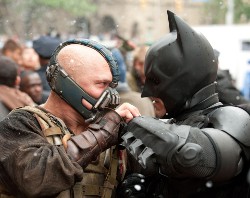 Christopher Nolan’s The Dark Knight Rises is an incredibly ballsy movie.
Christopher Nolan’s The Dark Knight Rises is an incredibly ballsy movie.
I don’t mean its scope and ambition, both of which are indeed impressive. I mean the audacity of choices that could have easily backfired: following Heath Ledger’s nuanced, razor-sharp Joker with the nearly blank thug Bane; recycling Batman Begins’ sinister plot, doomsday machine, and League of Shadows; inserting teenage-boy masturbation fantasy Catwoman into a universe largely devoid of sex appeal and camp (and non-Rachel Dawes women, period); crafting a lengthy, convoluted first act made even less comprehensible because of the sound design and score; and relegating Batman to captivity of one sort or another for the vast majority of the movie’s first 115 minutes.
The conditions Nolan imposes on Batman and Bruce Wayne are similarly challenging. He’s older and gimpy, still a scapegoat for the death of Harvey Dent, lacking purpose, and hiding in his rebuilt mansion. When he emerges from seclusion, he’s not facing individual foes but a disciplined, driven army, and a stunning plan for the destruction of Gotham that appears to have anticipated every eventuality – and ensures that the Dark Knight won’t be rising anytime soon.
Rises, then, feels like a triumph over much longer odds than either Nolan or Batman has ever faced, its success harder. Beyond all of the above, there’s the obvious second-sequels-suck problem, impossibly high fan expectations, and the issue of how to manage the expansion of scale that tends to happen in a series. (Each of Nolan’s Batman sequels has added 12 minutes to the previous movie.)
Most crucially, there’s balancing the legacy of the past with the need for the new – how to (a) wrap up the story (b) in a fitting way (c) while respecting the integrity of the whole, (d) avoiding redundancy, and (e) saying something fresh. [And (f) leaving an opening for sequels and/or spin-offs in case Warner Bros. doesn’t want a clean reboot in 2016.] Five out of six ain’t bad at all.
Despite Nolan’s limitations as a storyteller – most obviously, that he still refuses to fully trust the intelligence of his audience, relying here on unnecessary flashes to Batman Begins – he’s absurdly confident in his vision, skills, and collaborators, and The Dark Knight Rises, as expected, is robust with conviction and concepts, is full of relatively rich and even touching performances, and (through its locations, cinematography, production design, and visual effects) creates a new Gotham that feels authentic, tangible, and ultimately under siege and scarred.
The dialogue is a marked improvement, with better one-liners and fewer beat-you-over-head moments.
And with what is finally revealed as a tight script (despite the 155-minute feature running time) built on a clean, classic three-act structure, the movie emerges as Nolan’s most complete and satisfying since The Prestige – and one that will likely stand as the best of the series.
What the writer/director – and co-writers David S. Goyer and Jonathan Nolan – have essentially done is remake Batman Begins with The Dark Knight’s urgency while avoiding the pitfalls of the earlier movies. Begins was a rigorous, thoughtful recasting of the Batman mythology, but with each new entry it has felt more wan, lacking the vigor and magnitude of its successors. The Dark Knight was grander and had a real sense of danger but had to be carried on the backs of Heath Ledger and, to a lesser extent, Aaron Eckhart – his easy charm contrasted with his visceral, authentic anguish and rage.
To those films’ core strengths (but without the benefit of either Ledger or Eckhart), the Nolans and Goyer have added a sort of post-apocalyptic city – before the actual, impending, and seemingly inevitable apocalypse. Rises has a bracing, detailed second act in which the ruling classes and police have been cast out, and we get a sense of what a Gotham without Batman would look like. (In one of the best bits, Cillian Murphy is repaid handsomely for the shit corny lines he had in The Dark Knight.)
And the closing act is brutally bravura and finally cathartic, with surprising but fairly foreshadowed developments, and an unexpectedly emotional conclusion that finally delivers Bruce Wayne from his damaged psyche.
All the Pieces Matter (Eventually)
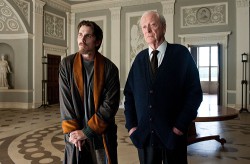 Getting there, though, takes patience and effort. The opening act, on first viewing, feels far too complicated, with so many new moving parts that don’t appear poised to pay dividends.
Getting there, though, takes patience and effort. The opening act, on first viewing, feels far too complicated, with so many new moving parts that don’t appear poised to pay dividends.
The first sequence – coming immediately after a brief prologue from Harvey Dent’s public funeral – offers nothing but spectacle and confusion. The primary function is to introduce the mysterious “mercenary” known as Bane, and there’s a bunch of stuff involved in his minions crashing a CIA plane that’s transporting a target, including what appears to be a blood transfusion under less-than-ideal conditions. It’s hard enough to follow the de-contextualized action as it is, but Bane’s mask – and, more critically, how the sound team manipulated the voice of a bulked-up Tom Hardy – mean that the audience is always chasing his words, trying to figure out what the hell he just said.
Nolan clearly doesn’t expect comprehension here, and the remainder of the roughly-75-minute act is similarly dense with people and information and events whose import or function is unclear.
The basic framework is pretty straightforward. Batman has been retired for eight years, and Bruce Wayne hobbles around with a cane. (In one funny scene, he’s told by a doctor that his knees and elbow and brain and kidney can’t handle heli-skiing.) And Bane has assembled a literal underground army. As one kid tells a cop, there’s apparently more work in the sewers than on the streets.
All the expected players return, with both Michael Caine and Morgan Freeman given early opportunities to shine. When Caine’s Alfred accuses Bruce of wanting to fail – preferring to die instead of trying to create a life for himself as a person and not a symbol – he’s curtly dismissed in one of the few respites from the movie’s aural assault; it ranks as both a low point for Bruce Wayne as a human being and a high point for Caine and Christian Bale in the series. Freeman’s Lucius Fox, with his sly, knowing smile and warm tone, gently pushes Bruce’s buttons. Gary Oldman’s Jim Gordon, meanwhile, seems beaten down by the period between The Dark Knight and Rises, marginalized in the police department and conflicted about how Dent’s death was used to clean up Gotham.
As for Bale, he looks revitalized by Bruce Wayne’s new fallibility and pathos, infusing him with a complexity beyond the rote duality inherent in his character. When he smiles and says he’s impersonating billionaire Bruce Wayne at a charity costume ball, it’s both obviously funny and a thinly veiled self-critique, an acknowledgment that he no longer has any real identity to cling to.
But everything else feels muddled. (The second time through, with a sense of the whole, clicks a lot more quickly.) There’s a lot of Wayne Enterprises-related business, with Marion Cotillard’s nuclear-fusion-energy investor eager to cozy up to Bruce Wayne and a pair of shady businessmen playing multiple sides. There’s Bane’s stock-exchange invasion, which bankrupts Bruce Wayne and draws a rusty Batman out of retirement – only to find that he’s pubic enemy number one for the dullard depu
ty police commissioner (Matthew Modine). And then there’s the sharp young cop (Joseph Gordon-Levitt), who pokes both Commissioner Gordon and Bruce Wayne for their flaws.
I don’t mean to suggest that the opening act – basically, the movie’s first half – is bad; it’s just a slog the first time through, at once meticulously, maddeningly patient and dizzyingly busy.
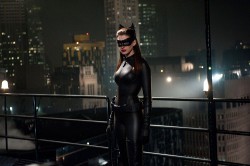 The life preserver here is Anne Hathaway’s Selina Kyle, the charming and resourceful burglar and grifter whom we meet in Wayne Manor stealing the pearls of Bruce’s late mother – and his fingerprints.
The life preserver here is Anne Hathaway’s Selina Kyle, the charming and resourceful burglar and grifter whom we meet in Wayne Manor stealing the pearls of Bruce’s late mother – and his fingerprints.
The Catwoman role is, of course, typically defined by the costume, and her getup’s style might be called functional fetish – more utilitarian than showy, but showy enough. Hathaway’s performance, though, easily transcends objectification: Her poised sexiness is her first tool – watch her walk – but Hathaway’s arsenal is considerable, credibly lethal in fight sequences, and through voice and expression clearly, playfully dangerous, desperate, and (as she says) “adaptable.” Her arc is easy to guess, but she’s just inscrutable enough to raise a doubt, and Nolan and Hathaway make her both vital and essential.
And it’s a pleasure to see Bruce Wayne seduced in Rises – sexually by Cotillard’s Miranda Tate and in a flirty, tentative fashion by Kyle. He delivers his Rachel-was-my-salvation speech early to Alfred, but he seems to move on, apparently not immune to the wiles of the living.
Even better is the fact that his casual submission to the charms of complicated women is not without consequence. In one of many misjudgments of character in the movie, Batman asks Selina to take him to Bane in the sewers, knowing full well that she is of liquid moral character. She watches with horrified wonder as the hulk – an unusually dedicated mercenary, by the way – nearly snaps the Batman in half over his knee.
It is at this point – the end of the first act, with all its pieces in place – that the movie starts to coalesce. Bruce Wayne is imprisoned far away in a striking prison resembling a well, and Bane reveals his plan to the public: blowing up all but one of the bridges connecting Gotham to the rest of the world, trapping nearly the entire police force underground, and unveiling a nuclear bomb at a football game while promising to return the city to its citizens without interference from the outside world. (There’s one little detail he neglects to tell the crowd, but no matter.)
As the plot begins to finally hurtle forward, though, Bane remains problematic. I won’t belabor a point so many others have made, but his mask – while up to the series’ high production-design standards and a requirement of the character – doesn’t merely obscure his expression; it and the sound design turn his voice to an an enveloping mush. (The movie will benefit greatly from subtitles.)
And Hardy – whom I loved in Inception and Warrior – appears to have put all his energy into bulking up and developing strange cadences for Bane; he is an impressive physical specimen and fighter, but there is little life, menace, or intelligence in either his face or his eyes. (We get precisely one look at his full, soulful, wounded face, and it underscores how wasted the actor was.)
Yet there are hints in the writing of an interesting character. A few times he’s earnestly, hilariously polite. And he has a great moment when he says (to himself) “What a lovely, lovely voice” during a boy’s singing of the national anthem. (It’s not quite a throwaway, as we’re reminded that the League of Shadows wants to destroy Gotham because of its deeply rooted corruption. These guys can still be moved by music – savage beasts and all.)
More importantly, he is (in the DC universe and the movie) obviously smart, as evidenced in Rises by his thorough, jaw-droppingly inventive long-term strategy with multiple fail-safes. (He seems to have some well-placed assistance, yet even if his schemes weren’t developed alone, he is apparently charismatic enough to assemble a loyal army.) Some hint of this in the performance would have made him a much more compelling villain.
But Bane’s hulking presence, while a disappointment in terms of execution, doesn’t really drag the movie down much. Like his nemesis and Ra’s al Ghul, he doesn’t need to be vivid, because he’s a symbol more than a man.
Portraits in Hypocrisy
But what is he a symbol of? As he stands before the people of Gotham on a football field turned sinkhole, he calls himself a liberator – although his real plan is to liberate them from the face of the Earth.
At Slate.com, Dana Stevens wrote:
“The Dark Knight Rises bursts at the seams with the kind of urgent, vague political references that fall just short of being ideas. … Exactly what conclusions we should be drawing from this … cogitation on social issues is never clear, but maybe that’s of a piece with the moral ambiguity of Bale’s Batman, who’s always split the difference between idealist hero and nihilist vigilante.”
It’s not the first time I’ve heard the word “vague” paired with Nolan’s Batman movies, and in writing about The Dark Knight, I myself said that it seemed to “glibly endorse oligarchy and … disregard … due process,” epitomized by Fox’s objections to surveillance masking his assent (just this one time, though).
The first mistake here is to conflate the characters’ words and actions with an authorial endorsement – the premise that the Nolans and Goyer are attempting to use Batman or the Joker or anybody else as a mouthpiece for their own political thoughts. The second mistake is to pay any attention to the words at all.
The key here is to get past each person’s stated justifications for their behavior and instead focus on the actions themselves – and through that process to see (most of) them as hypocrites. (The polite way of saying that is noting Batman’s “dual” nature, but let’s not be coy.) Two-Face wasn’t merely a quickly and easily dispatched villain in The Dark Knight; he’s the whole damned enterprise personified.
So yes, the Joker verbally advocates chaos, but he executes complicated schemes that nearly require predictable behavior. In public, Bane talks like a populist revolutionary; but he is a political and corporate terrorist who, once he seizes power, functions as a totalitarian ruler. (Sadism is his true philosophy, and – as Nolan’s “plausible” explanation for why this villain’s plan is so unnecessarily drawn-out, allowing our hero a chance to foil it – it’s nearly a subtle joke.) Selina Kyle whispers threateningly into Bruce Wayne’s ear about the coming “storm” that will wreak havoc on the rich, but it’s clear early and explicitly that she’s more a skilled opportunist than hardened ideologue.
On the other side of the law, Jim Gordon has himself become two-faced (if conflicted), praising Harvey Dent in the new movie while wanting to tell the truth about him. His hypocrisy, in the two Dark Knight movies, is couched in pragmatism: He works with crooked cops because that’s all there are, and the lie does more good than harm. Freeman’s Fox is charming and fully likable, but he’s a go-along-to-get-along guy.
And then there’s the Dark Knight himself, who says the right things about doing good and has two related rules (no deliberate killing, no handguns) that can’t begin to disguise his disregard for life, limb, and property. That he restates those governing principles to Selina as they forge a bond of convenience is an exp
ert illustration of self-delusion; Batman clings to these effectively arbitrary strictures to reassure himself that he is different from his enemies.
So if you’re looking at any of the words of the iconic heroes or villains for guidance on how to interpret these movies, yes, they will come off as politically vague, or more accurately contradictory. Arguably the sagest line in the entire trilogy warns against putting too much stock into speech or ideas or philosophy or motives: “Some men just want to watch the world burn.”
As has been widely noted, Rises casts itself in Occupy and class-warfare terms – replacing its forebear’s mantra of terrorism – and the theme resonates naturally, with the people’s dark protector also being a personification of the privileged 1 percent. But the revolutionary threats and speeches are just talk, and when war does come, it’s one trained army against another in a street fight, Batman’s cops charging Bane’s criminals in the winter sun and flitting snowflakes.
This daylight battle highlights that Nolan’s Batman movies have primarily dealt with oligarchical and authoritarian structures and militant responses. There are regular references throughout the series to the people of Gotham (and their collective character), but it’s an abstract concept to the self-appointed arbiters of their fates – be they forces largely for good (Batman) or evil (Ra’s al Ghul, the Joker, Bane). Even the elected and appointed public officials (Harvey Dent, the mayor, and Jim Gordon) conspire to evade the spirit of the law in the interest of “18 months of clean streets” – security at the expense of civil liberties.
The bleakness of the series under Nolan flows directly from this. Batman Begins asks the audience to decide among crime-ridden streets, a safer community cleaned up by the unaccountable Batman, and destruction. The Dark Knight pits terrorism against a surveillance state. These are easy calls, but they’re menus of extreme and false choices. If these movies have anything to say in political terms, it’s an easy cautionary statement about power and means and circumstances corrupting ideals – about compromised morals.
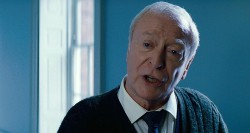 Nolan has in the series offered a few contrasts – but with major caveats. Ra’s al Ghul and the League of Shadows have a cogent, coherent philosophy, but it of course judges society as a whole and places no value on individual human life or action. Alfred speaks truth (actually, “troof”) and sense and wisdom to his young charge, but his interest is personal rather than ethical, and his nature is fundamentally deferential – even if we now know that he has his limits. Rachel came close to being a credible moral voice, but her relationships with Bruce and Harvey represented conflicts of interest.
Nolan has in the series offered a few contrasts – but with major caveats. Ra’s al Ghul and the League of Shadows have a cogent, coherent philosophy, but it of course judges society as a whole and places no value on individual human life or action. Alfred speaks truth (actually, “troof”) and sense and wisdom to his young charge, but his interest is personal rather than ethical, and his nature is fundamentally deferential – even if we now know that he has his limits. Rachel came close to being a credible moral voice, but her relationships with Bruce and Harvey represented conflicts of interest.
The Hero Gotham Needs
With the addition of one character, The Dark Knight Rises forcefully re-frames Nolan’s Batman movies in personal moral rather than socio-political terms.
This conceptual construct was certainly suggested by The Dark Knight, filled with quandaries of situational ethics. The Joker can be seen as amoral – he faults Batman for those pesky rules – but he also seems genuinely curious about the choices people make. Will Batman let people die to protect his identity? Will he choose to save Harvey or Rachel? Will either set of boat people blow up the other? How many people will try to murder a nobody to save a hospital? Will anybody stop them? The self-made luck of Dent’s two-headed coin – in which he was clearly responsible for the outcome – was with Two-Face replaced by genuine chance; does that somehow absolve him?
But that movie was cloudy, in large part because both the Joker and Two-Face were insane. It also lacked shape, increasingly entropic as a reflection of its villains, neither with an endgame. So it was hard to feel confident in reading it.
With the whole trilogy in front of us, though, the task becomes a little easier. Rises mimics Batman Begins in story, theme, structure, and the interweaving of disparate threads from the Batman comics universe; they are clear (and clearly intentional) contrasts to the disorder of the middle chapter. The Joker and Two-Face raise philosophical questions but cannot resolve them; the bookend movies provide some answers.
In Batman Begins, Ra’s al Ghul was the voice of dubious moral certainty that Batman rejected – but only with his line-item veto. The hero drew a line at killing, and the result was two distinct but equally troublesome codes, radically different in means and ends but substantially similar in ethos: one pure but evil, the other gray but good.
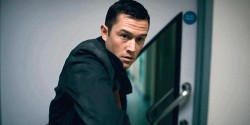 In The Dark Knight Rises, Gordon-Levitt’s John Blake becomes the unambiguous, unencumbered, self-righteous, and righteous moral authority that the series had – by design, I think – lacked. He recalls the idealism of a younger Bruce Wayne without the revenge jones or self-loathing, and he has the elementary decency of a younger Jim Gordon. Like Bruce, he’s an orphan; like Gordon, he’s a cop. And he rightly sees both of them as failures; for all the good they’ve done, they’ve also caused great harm, and their hands are, as he says, “plenty filthy.”
In The Dark Knight Rises, Gordon-Levitt’s John Blake becomes the unambiguous, unencumbered, self-righteous, and righteous moral authority that the series had – by design, I think – lacked. He recalls the idealism of a younger Bruce Wayne without the revenge jones or self-loathing, and he has the elementary decency of a younger Jim Gordon. Like Bruce, he’s an orphan; like Gordon, he’s a cop. And he rightly sees both of them as failures; for all the good they’ve done, they’ve also caused great harm, and their hands are, as he says, “plenty filthy.”
Unlike Alfred – who’s motivated by love rather than any moral code, and who casts his big Rises confrontation with Bruce in gentle, hypothetical terms – Blake speaks truth to power, and he’s the most clear-eyed person in the series, a conscience nagging people who haven’t just crossed a line; they’re so far past the line that they can barely remember the other side.
And he walks the talk. Late in the movie, he foolishly but bravely risks his life in an effort to clear a blockade of Gotham’s remaining bridge. He stands up for others, without compromising his ideals.
The Dark Knight Rises – indeed, Nolan’s whole trilogy – cautiously casts its lot with Blake. Batman, while still capable of heroic deeds, is at core a lost cause – as is Bruce Wayne while Batman darkens his door.
Blake, though, looks like he might be a white knight, the kind of hero Gotham needs rather than deserves.
That probably sounds familiar. After all, Harvey Dent looked incorruptible, too.

